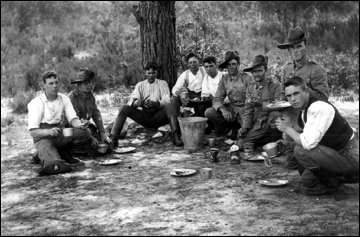The Victorian Rangers

Cheltenham Rangers Annual Dance.
The establishment of the Victorian Rifle Volunteers arose from members of rifle clubs in country districts of Victoria wishing to become a recognised military body. Approval was given in 1888 for the formation of Companies A and B with detachments at many rifle clubs including Rupanyup, Stawell, Ararat, Charlton and Donald. Membership was for a period of 3 years with age of members being from 18 to 35. Boys of fourteen could be admitted to the corps to be trained as drummers, buglers or musicians. It was on March 5, 1889 that the Victorian Rifle Volunteers became officially known as the Victorian Rangers.
"Members were supplied with a Martini-Henri rifle complete with bayonet and leather sling; waist belt, fog, bandolier and pouch made from brown leather. Every member was required to provide himself with the authorized uniform consisting of a khaki cloth jacket with scarlet collar and cuffs, khaki trousers with a scarlet welt. The head dress consisted of a brown felt hat looped up on the right side and held in place by a lion’s head as a brass bade, the puggaree with a pleat of three folds of material, also khaki. The dress was completed by brown canvas leggings and black angle boots. At a later period the head dress was altered from the felt hat to the khaki cloth helmet." (Peacock 1938:3)
It was on July 22, 1889 that permission was given to form G Company with headquarters located at Cheltenham and detachments at Mordialloc, Mentone, East Brighton and South Brighton. Company G became part of 3rd Battalion in 1891 with Cheltenham being the site of battalion headquarters. The battalion commander was Major Robert Edward Rigg, headmaster of Mordialloc State School from 1877-1905, and local preacher in the Methodist Church. In August 1897 the Victorian Rangers were reorganised into two battalions with Company G joining 1st Battalion whose headquarters was located at Dandenong.
Five years prior to this reorganisation the Victorian Rangers undertook manoeuvres at Moama in New South Wales. As Peacock (1938:11) writes, "The occasion was the first time in the history of Australia that an armed Force from Victoria had entered the Colony of New South Wales. The visitation of the Victorian Rangers to Moama, and therefore to New South Wales, was a national event, and to break down that military barrier in a social and friendly, yet military way, was a master stroke of colonial military diplomacy." Representatives from many units of the Victorian Rangers took part in this event that was initiated by the Echuca detachment. Peacock notes, "The crack band of the Cheltenham company was there, and its men were massed with the Echuca band under Bandmaster Haig, Drum-Major Hall leading the van."

Cheltenham Rangers on meal break.
In 1899 the South African War commenced. Companies of troops were sent from several of the colonies. The 1st Victorian Contingent included members of the Victorian Rangers, some coming from the Cheltenham detachment. Taylor (1977:81) wrote the Boer War was very close to her because, "many Cheltenham men had decided to fight for the Queen and Country, and joined the Bushmen’s Contingent. The training camp was at Langwarrin, but on one occasion two hundred and sixty-five men of the Australian Imperial Mounted Bushmen camped at Cheltenham. When their training was over, the horsemen rode through Cheltenham four abreast on the way to their ship. Very fine they looked, too, in their slouch hats turned up at one side, each with its waving bunch of feathers."
